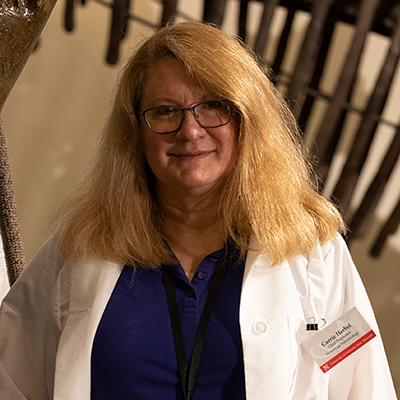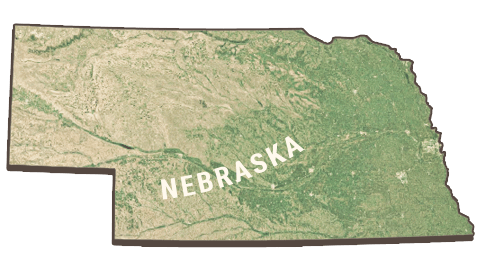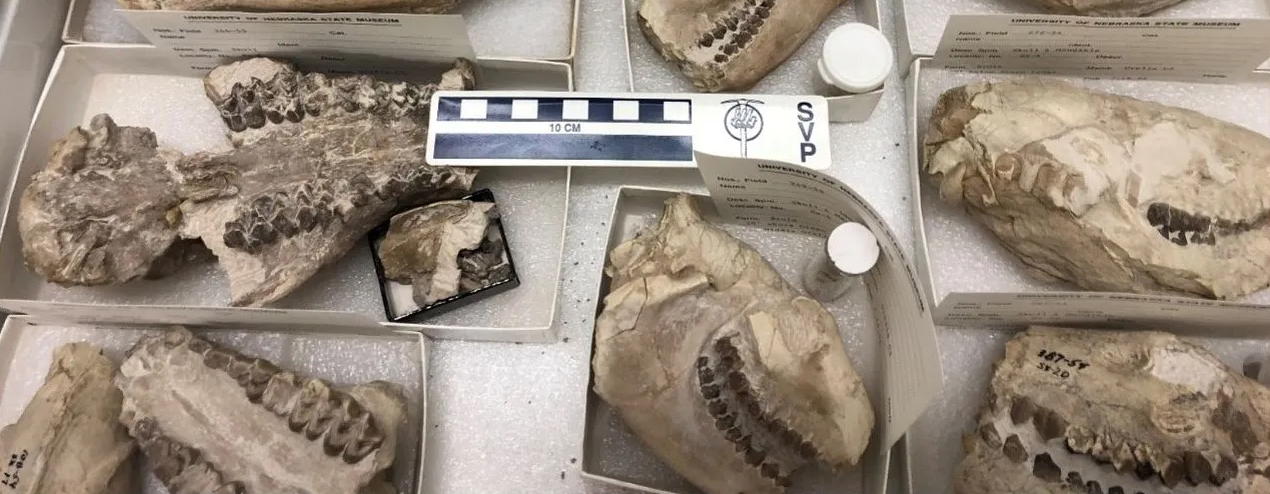
As Chief Preparator at the University of Nebraska State Museum, Herbel conducts field research and prepares specimens, uncovering the mysteries of Nebraska’s ancient mammalian species for future generations of researchers and museum visitors. In the museum’s preparation lab, using a suite of modern tools, Herbel extracts fossils from rock so that researchers from around the world can study them. She also coordinates the installation and preparation of permanent and temporary exhibits at the museum so that visitors can see how life on the Great Plains has evolved over time.
Carrie Herbel has always had a passion for the natural world. Growing up in Omaha, she often collected rocks and fossil bone fragments that she found while exploring the area near her home. She enthusiastically read books about ancient mammals, dinosaurs, geology, and plant life. Her pastime led her to pursue a master’s degree in geology at the University of Nebraska and eventually a career in paleontology.
Dr. Mike Voorhies was instrumental in helping Herbel choose a career in paleontology. He taught a course at the University of Nebraska called “Elephants of the Great Plains.” Herbel says that taking this course changed her life. Voorhies opened her eyes to the many possibilities of a career in paleontology and geology. Soon after, she changed her major from Civil Engineering to Geology and would later pursue a master's degree with Dr. Voorhies as her advisor. Under his direction, she successfully defended her thesis on the fossiliferous sands beneath the ash at Poison Ivy Quarry, which later became Ashfall State Park. Beneath the ash at the quarry, Herbel uncovered a partial gomphothere and a large camel on a field assignment. Due to their position apart from the layers of ash, Herbel’s discovery made the team question how these animals died, “If not the ash, then what led to their demise?” Herbel discovered that many of the bone fragments were products of carnivore activity and trampling, as other large herbivores came and went from this ancient watering hole.
Herbel’s research focuses on taphonomy—the study of the processes that affect organisms as they pass from death to burial to decomposition to preservation and fossilization. By carefully inspecting the fossil bones of mammals, it’s possible for researchers to understand how that individual lived and died. A bite mark on a bone could indicate how an animal was killed by a predator, but if the bone shows signs of healing around a bite mark, a story about the animal’s survival emerges.

 Prepared and rehoused Oreodont fossils that are ready to be studied by volunteers © University of Nebraska State Museum.
Prepared and rehoused Oreodont fossils that are ready to be studied by volunteers © University of Nebraska State Museum.Over the years, Carrie Herbel has mentored many undergraduate and graduate students in paleontology. She is dedicated to training the next generation of paleontologists. Herbel encourages students in their independent research by helping them develop their natural curiosity into research questions, while guiding them through all phases of the research process from the field to the lab. She also assists volunteers who dedicate their free time to prepare and preserve fossil specimens in the museum’s vertebrate paleontology research collections, including Project Oreodont, which was launched in 2016. The goal of the project is to process the University of Nebraska State Museum’s backlog of 1200 oreodont specimens, collected in northwest Nebraska, primarily from the 1930s to the 1950s, and more than 200 specimens donated by Morris Skinner. Oreodonts were a common group of sheep-sized hoofed mammals that roamed across North America for millions of years.
You can learn more about Project Oreodont on the University of Nebraska State Museum’s website: https://museum.unl.edu/about-us/behind-the-scenes/project-oreodont.html
Here are just a few 3D models of similar fossils that Carrie Herbel has prepared.
One of Herbel’s many responsibilities as a museum preparator is molding and casting replica fossils for use in museum exhibits and educational programs. She specializes in painting casts to look just like real fossils. When the mounted fossil skeletons in the museum’s exhibit halls are in need of repair, Herbel expertly repairs the broken pieces, or replaces fragile fossils that have been on exhibit for many years with replicas so that the originals can be returned to the museum’s research collections.
Herbel prepares fossils in the main research lab at Nebraska Hall where the museum’s research collections are housed. You can sometimes find her hard at work in the University of Nebraska State Museum’s Visible Lab (located on the museum’s fourth floor), where you might see her preparing a rare brontothere skull. A brontothere is an extinct mammal that once roamed the Great Plains over 34 million years ago.
Herbel’s museum research examines the effects of preparation techniques on fossil bones. She became interested in this field of study after she observed how fossil bones were affected by shellac, a resin once used by preparators to harden fragile fossil bones. After a few decades, time, heat, and humidity can cause shellac to flake away, which pulls on the surface of the fossil bone and leads to chipping. Herbel now encourages museum preparators to avoid the use of shellac and other chemical treatments, which can damage fossil bones. To find a better method of preservation, Herbel is experimenting with various glues and consolidant mixtures, observing how they react with fossil bones over time. This work could lead to a breakthrough discovery, adding to her many valuable contributions to paleontology and museum science.
Herbel, Carrie. “Bones Uncovered,” Raptor Review, Issue 23, January 2014, Utah State University Eastern Prehistoric Museum.
Herbel, C.L. 1994. Taphonomy of the "fragmental layser," Cap Rock Member, Ash Hollow Formation, Ogallala Group (Miocene) in northeastern Nebraska. M.S. Thesis, Lincoln, University of Nebraska, 100 p.